1. This screen is updated, and buy new 7inch TN DSI screen V3.0 for Raspberry Pi from
| Buy from OSOYOO |
Buy from US |
Buy from UK |
Buy from DE |
Buy from IT |
Buy from FR |
Buy from ES |
Buy from JP |
 |
 |
 |
 |
 |
 |
 |
 |
2. DSI cable for Raspberry Pi 5
| Buy from OSOYOO |
Buy from US |
Buy from UK |
Buy from DE |
Buy from IT |
Buy from FR |
Buy from ES |
Buy from JP |
 |
 |
 |
 |
 |
 |
 |
 |
3. DSI cable for Raspberry Pi 4
| Buy from OSOYOO |
Buy from US |
Buy from UK |
Buy from DE |
Buy from IT |
Buy from FR |
Buy from ES |
Buy from JP |
 |
 |
 |
 |
 |
 |
 |
 |
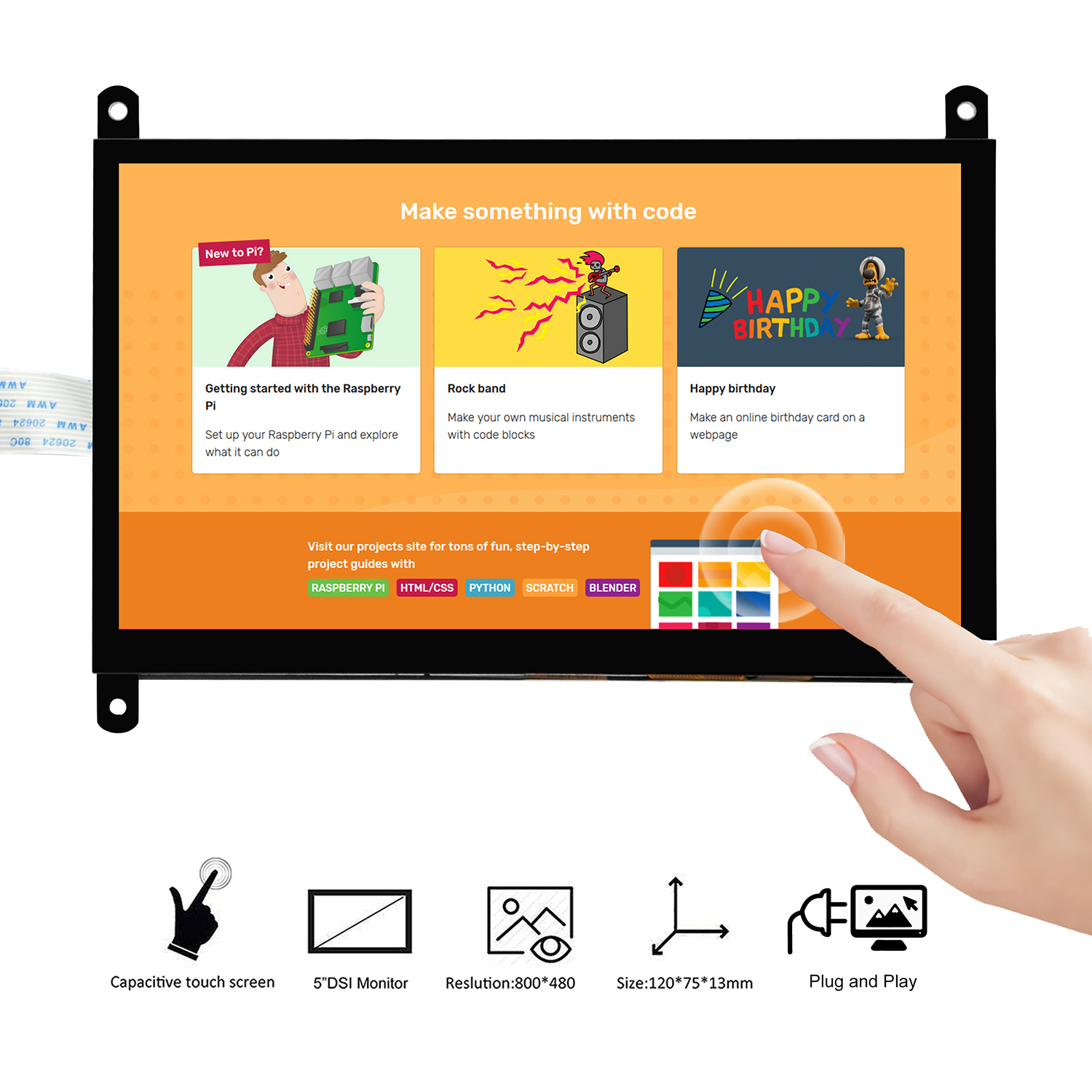
Caution
- This LCD display supports Raspbian, Ubuntu MATE, Snappy Ubuntu Core, OSMC, and Windows 10 IOT Core and so on. Please download your system image from raspberry Pi official website: https://www.raspberrypi.org/downloads/
- Please make sure that your TF card (Micro SD) has enough space to write system image
- Do not even touch your raspberry pi board when power is on or your hand has static charge (you can move static charge by touching metal tap)
Introduction
The 7″ LCD display is an LCD display which connects to the Raspberry Pi through the DSI connector. It is capacitive touch LCD. It doesn’t need install driver, and you can plug and play. The Physical resolution of LCD display is 800*480.
Feature
- Only Use DSI interface Connects to the Raspberry Pi board include power;
- The refresh frequency about 60HZ;
- Physical resolution 800*480, 24-bit color;
- Size 16.5*12.2cm;
- Support multiple finger touch in Ubuntu and Windows IoT OS (1 Finger Touch in Rasbian)
- 70/70/70/70 degree viewing angle;
- Free drive support Raspberry ,Ubuntu MATE, Kali, RetroPie, OpenElec, OSMC, Archsystem and so on;
- Strong anti-interference;
- Ultra low power ,ultra-long distance lossless transmission, The screen will automatically sleep when it is not in use;
- The display size have changed from 800×480 to 1920×1080;
- It supports Raspberry Pi 2/3/3B+/4
- Working temperature -5° C to 38° C . Not suggest to work in high humid or extreme temperature environment.
Parameter
| Item |
unit |
Min |
Type |
Max |
| Size |
cm |
— |
16.5*12.2 |
— |
| Physical resolution |
— |
— |
800*480 |
— |
| frequency |
HZ |
— |
60 |
— |
| rated power |
mw |
600 |
800 |
980 |
| Backlight power |
mw |
550 |
750 |
920 |
| Main chip |
mw |
40 |
45 |
60 |
| Distance transmission |
cm |
– |
10 |
60+ |
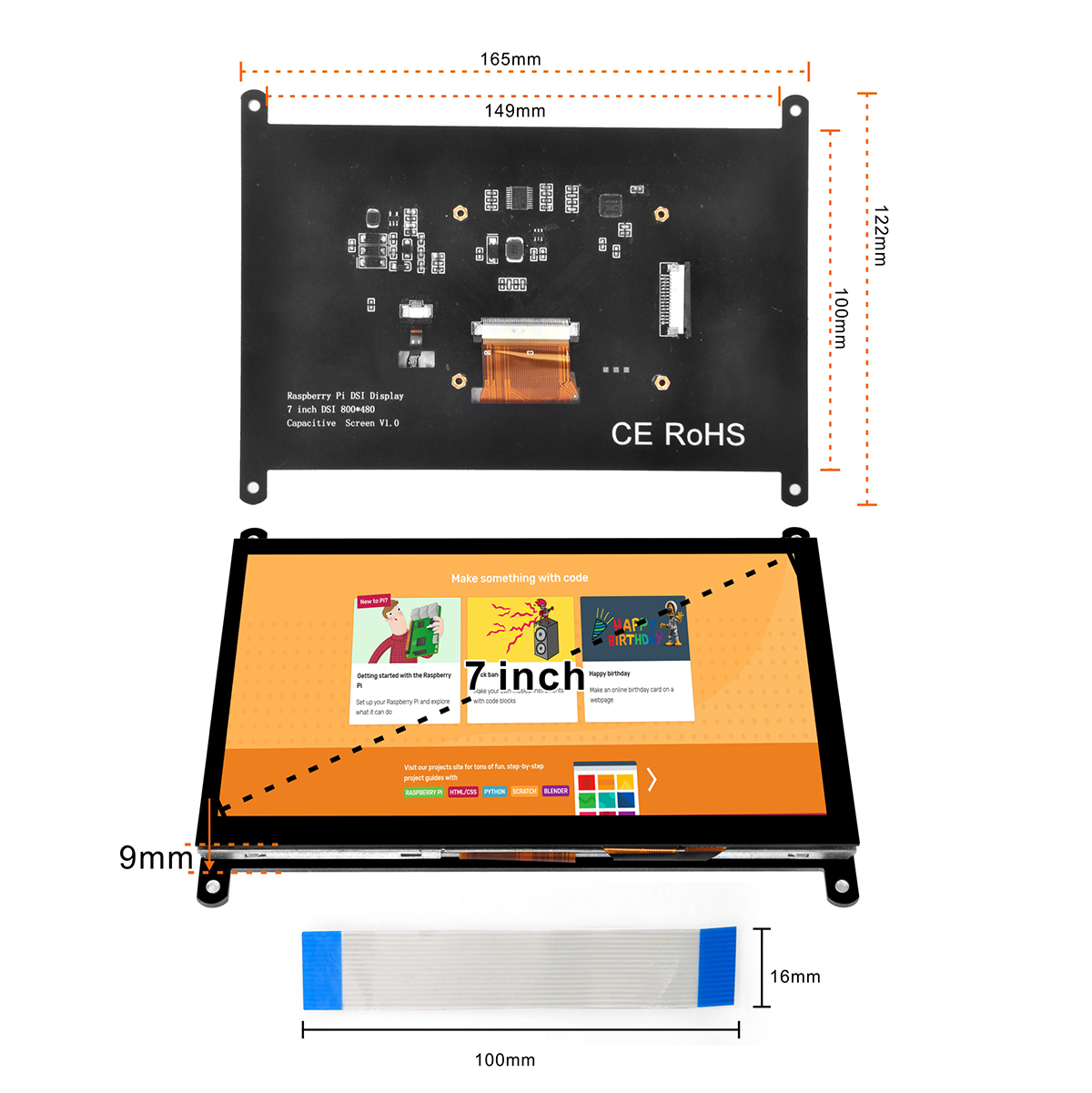
Using guide
Parts Needed
You will need the following parts:
- 1x Raspberry Pi 2/3/3B+/4
- 1x Power USB adapter
- 1x Power USB cable
- 1x 7″ DSI touch screen
- 1x Micro SD card (new and 16GB up)
- 1x TF card reader
How to install DSI cable?
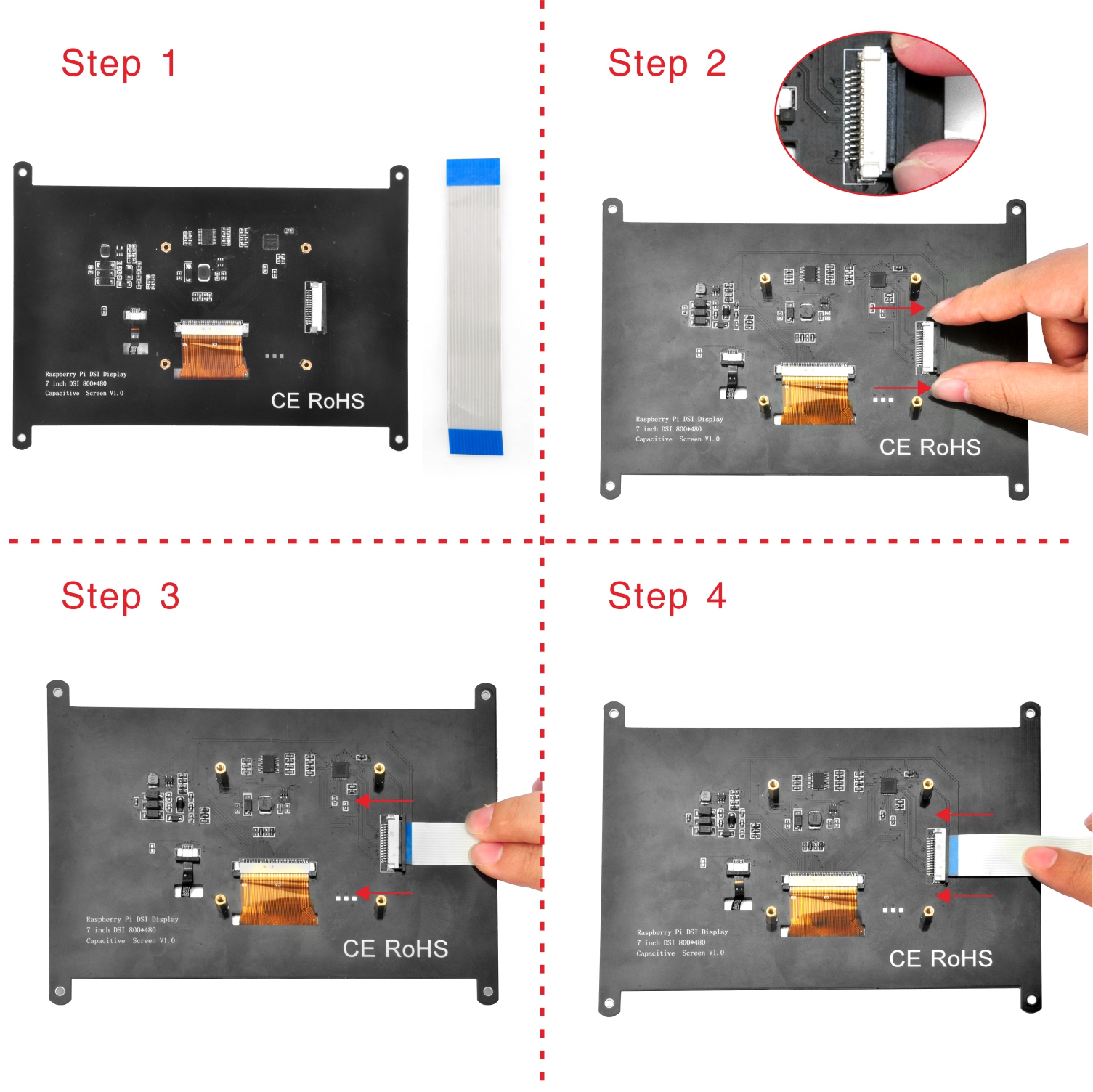
How to install OS?
7″ DSI LCD supports IMG system such as Raspbian, Ubuntu MATE, Snappy Ubuntu Core, OSMC, and Windows 10 IOT Core and so on. Please follow as below:
Firstly, Download IMG system in your computer from the raspberry pi official website: https://www.raspberrypi.org/downloads/

Secondly, Unzip the IMG system, and open your imager writer (recommend win32diskimager from: https://sourceforge.net/projects/win32diskimager/);
Thirdly, Insert the SD card into the card reader, and connect with computer, and select the image system and the device, and then click “write”, as below:
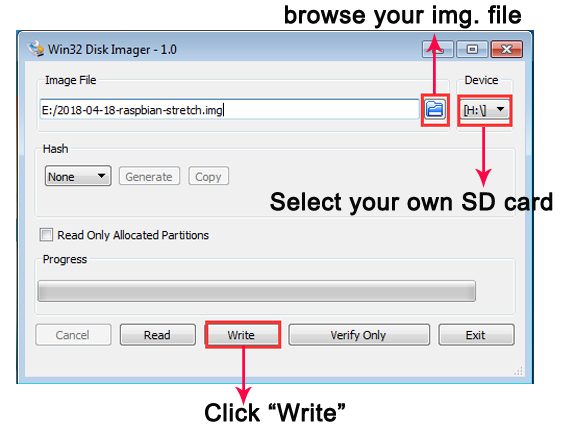
Fourthly, Insert the SD card into raspberry pi board and assemble 7″ DSI touch screen as below:

At last, Power up wait for the system to start (Note: Do not even touch your raspberry pi board when power is on or your hand has static charge):

How to add a virtual keyboard on to the screen?
The touch screen can be used as a mouse device. When we need to input text data to Raspberry Pi board, normally we have to connect a USB keyboard to Pi and this is really inconvenient.
Is there any solution which can use the touch screen itself to work as a text input device same as mobile phone?
The answer is Yes. You can install a virtual keyboard to replace the USB keyboard.
Here are the instructions:
Step 1) Install matchbox-keyboard by typing following commands in your pi terminal:
sudo apt update
sudo apt upgrade
sudo apt install matchbox-keyboard
Step 2) Click RaspberryPi icon in the top-left corner as following:

Step 3) Click Accessories->Keyboard as following:
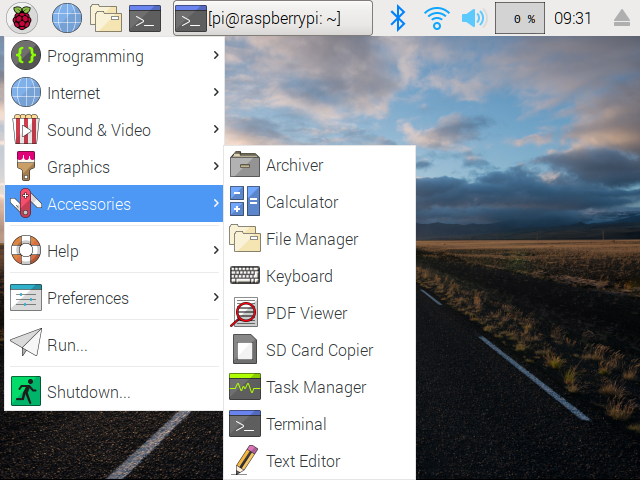
You will see a pop-up virtual keyboard as following:
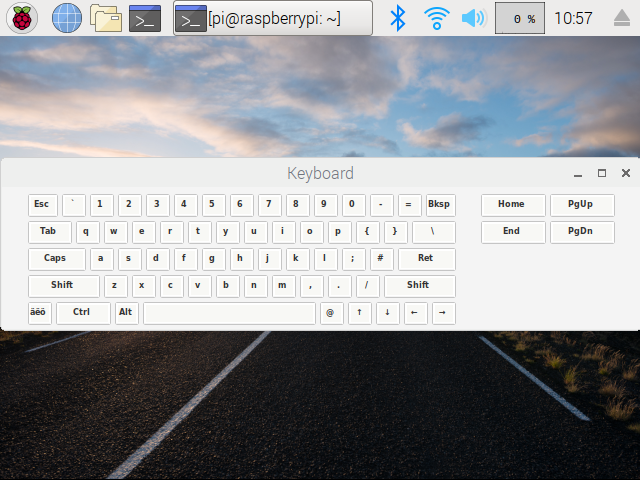
If you have want more detail about matchbox-keyboard installation, read this link:
https://osoyoo.com/2019/04/09/osoyoo-7inch-hdmi-touchscreen-keyboard-matchbox-keyboard/
Advanced course
How to adjust virtual resolution:
Note: This method only supports Raspberry Pi Legacy OS. If working with Raspberry Pi BOOKWORM OS, the DSI screen cannot adjust resolution.
The physical resolution is 800*480, but you can adjust the resolution form 800×480 to 1920×1080. Open micro SD card which you have installed IMG system and then open “/boot/config.txt” via Notepad++, and find the following lines:

If you like 1920*1080, you can adjust it as below and save this file:
framebuffer_width=1920
framebuffer_height=1080
Note: If you use Raspberry Pi 4, you also need to comment the lines in “/boot/config.txt” : #dtoverlay=cv4-kms-v3d.
How to adjust rotation of display:
Note: This method works with Raspberry Pi Legacy OS.
LCD displays have an optimum viewing angle, and depending on how the screen is mounted it may be necessary to change the orientation of the display to give the best results. By default, the Raspberry Pi display and Raspberry Pi are set up to work best when viewed from slightly above, for example on a desktop. If viewing from below, you can physically rotate the display, and then tell the system software to compensate by running the screen upside down.
To flip the display, add, anywhere in the file \boot\config.txt, the following line:
display_rotate=2
lcd_rotate=2
This will vertically flip the LCD and the touch screen, compensating for the physical orientation of the display
rotate=0 means Normal
rotate=1 means 90 degrees clockwise rotation
rotate=2 means 180 degrees clockwise rotation
rotate=3 means 270 degrees clockwise rotation
rotate=0x10000 means horizontal flip
rotate=0x20000 means vertical flip
How to adjust the brightness:
The following operations are based on Raspbian
(1) Run the following command in terminal to switch user permission as administrator
sudo su root
(2) Run the follwing command to adjust brightness of display (change the number 100 to any number from 0 to 255)
echo 100 > /sys/class/backlight/rpi_backlight/brightness
Note: If failing to adjust the brightness, please check the line “disable_touchscreen=1 ” in /boot/config.txt and comment it out “#disable_touchscreen=1 #”























Where can i find rohs and CE certifications?
Thank you